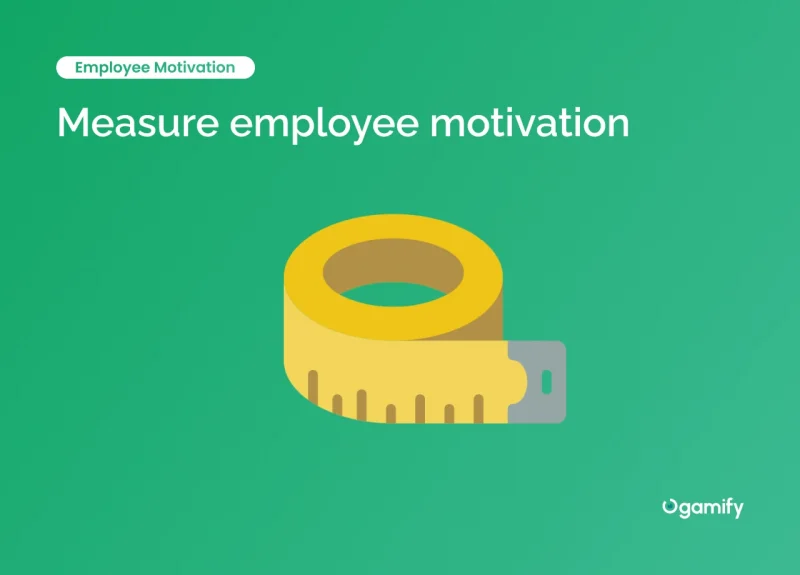Unlocking the secrets of motivated employees is a crucial challenge for any organization. Understanding how to measure motivation and effectively gauge employee motivation levels is essential for driving workplace success.
In this article, we will explore the importance of measuring employee motivation and delve into practical strategies on how to measure motivation to create a thriving and engaged workforce. Discover how to unlock your team’s true potential by unravelling the mysteries of motivation.
Why is it important to measure employee motivation?

Measuring motivation is a crucial aspect of managing a successful and productive workforce. Motivated employees are more engaged, satisfied, and committed to their work, ultimately leading to higher productivity and overall success for the organization.
By understanding and measuring motivation, employers can identify areas lacking motivation and take proactive steps to address these issues. In this article, we will explore how to measure motivation in your company, why it is essential, and strategies to increase levels of motivation.
How to measure motivation in your company

Measuring motivation in your company requires a comprehensive approach that considers various factors and indicators. While motivation is subjective and complex, several methods and tools can provide valuable insights. Let’s explore some effective ways to measure employee motivation:
Surveys and Questionnaires:
Designing surveys or questionnaires specific to measuring motivation can be valuable for gathering quantitative and qualitative data. These surveys can include a range of questions to understand workplace motivation, identify factors contributing to motivation, and gain insight into employees’ perceptions of their motivation levels. By utilizing well-designed surveys and questionnaires, organizations can obtain valuable data that helps them evaluate and assess motivation within the workforce.
The quantitative data can provide statistical insights, while the qualitative responses offer rich and nuanced information about employees’ motivations, aspirations, and challenges. This comprehensive approach to measuring motivation allows organizations to identify trends, patterns, and areas of improvement, enabling them to develop targeted strategies to enhance motivation levels and create a more engaged workforce.
Interviews and Focus Groups:
One-on-one interviews and focus group discussions provide a unique opportunity to delve deeper into individual motivations within the organization. These interactive sessions allow employees to express their thoughts, concerns, and suggestions openly, giving managers valuable insights into the factors influencing motivation. By conducting interviews, organizations can establish a personal connection with employees, fostering a sense of trust and creating an environment where employees feel comfortable sharing their perspectives.
On the other hand, focus groups offer a collaborative setting where team members can engage in open discussions and build upon each other’s ideas. Through interviews and focus groups, organizations can uncover underlying motivators, barriers, and aspirations that may not be captured through other measurement methods. These qualitative insights can help organizations tailor their approaches to enhance levels of motivation and address any underlying issues effectively.
Performance Metrics
Analyzing performance metrics provides an indirect yet insightful way to gauge employee engagement and motivation. By closely examining productivity levels, meeting targets, and goal attainment, organizations can gain valuable insights into the correlation between performance and motivation. A decline in performance may indicate a lack of motivation, suggesting that employees may be disengaged or facing challenges that hinder their motivation levels.
Conversely, consistent high performance could be an indicator of high motivation levels. By monitoring performance metrics, organizations can identify patterns and trends that shed light on the overall motivation levels within the workforce. This data-driven approach allows organizations to take proactive measures to enhance motivation by addressing specific areas of improvement and providing targeted support and resources where needed.
Peer Assessments
Incorporating peer assessments or feedback mechanisms is a powerful way to measure motivation levels among team members. Peer assessments involve team members evaluating and providing feedback on each other’s motivation levels, fostering a culture of open communication and collaboration. This approach offers valuable insights into individual motivation and creates a supportive environment where employees can learn from and support one another.
Peer assessments encourage employees to reflect on their motivation and that of their colleagues, fostering a sense of shared responsibility for maintaining high motivation levels within the team. By leveraging peers’ perspectives, organizations gain a holistic view of motivation dynamics and can implement targeted interventions to increase motivation and foster a collaborative and motivated work culture.
Absenteeism and Turnover Rates
Tracking absenteeism and turnover rates can serve as important indicators of motivation levels within the organization. High absenteeism and turnover rates can suggest low motivation and disengagement among employees. Employees who feel unmotivated or dissatisfied with their work may be more likely to be absent or seek opportunities elsewhere.
Monitoring these metrics allows organizations to identify patterns and potential issues related to motivation, providing insights into the overall health and morale of the workforce. By addressing underlying causes of absenteeism and turnover, such as low motivation or dissatisfaction, organizations can implement strategies to increase motivation and create a positive work environment that encourages employees to stay engaged and committed.
Observation and Feedback
Observing employees’ behaviour, engagement levels, and interactions provide qualitative insights into their motivation. Managers and leaders can closely monitor how employees approach their work, their level of enthusiasm, and their overall engagement. These observations offer valuable information about the motivation factors that drive employees’ performance and job satisfaction.
Additionally, providing timely and constructive feedback is crucial in enhancing motivation. Recognizing achievements and offering feedback helps employees feel valued and appreciated, reinforcing their motivation to perform at their best. Organizations can create a positive work environment that supports and nurtures employee performance by fostering a culture of open communication, observation, and feedback.
How to increase motivation levels?

Once you have measured the motivation levels within your company, it’s time to take proactive steps to enhance motivation and create a more engaged workforce. Here are some strategies to increase motivation levels:
Set Clear Goals
One powerful strategy to increase motivation is setting clear and meaningful goals. Clearly defining and communicating organizational and individual goals that align with the company’s vision provides employees with a sense of purpose and direction.
When employees clearly understand what they are working towards, it ignites their intrinsic motivation and drives them to pursue those goals actively. Moreover, challenging, attainable goals can inspire employees to stretch their capabilities and reach new heights. By regularly revisiting and reinforcing these goals, organizations can keep motivation levels high and ensure that employees stay focused and driven towards success.
Foster a Positive Work Environment
Creating a positive work environment is a fundamental factor in boosting motivation levels. When employees feel valued, appreciated, and respected, their motivation to excel naturally increases. Organizations should prioritize open communication, transparency, and inclusivity to foster such an environment.
Actively listen to employees’ concerns, ideas, and suggestions, and allow them to voice their opinions. Recognize and reward employees’ efforts and achievements, acknowledging their contributions to the organization’s success. Furthermore, promoting a healthy work-life balance and prioritizing employee well-being can significantly impact motivation. When employees feel supported and cared for, their cause to perform at their best remains consistently high.
Provide Autonomy and Ownership

Empowering employees with autonomy and ownership over their work can be a powerful driver of motivation. When employees are free to make decisions, contribute ideas, and control their tasks, it fosters a sense of ownership and responsibility. This autonomy allows individuals to tap into their intrinsic motivation, creativity, and problem-solving abilities.
Leaders and managers can delegate tasks, set clear expectations, and provide guidance while allowing employees to determine the best approach. By trusting employees and empowering them to take ownership, organizations create an environment where motivation thrives, and employees feel empowered to take the initiative and excel in their roles.
Offer Professional Development Opportunities
Investing in professional development opportunities is a crucial strategy for enhancing motivation levels. Providing employees with access to training programs, workshops, and learning opportunities enhances their skills and knowledge and sends a powerful message that the organization values their growth and career advancement.
Offering avenues for learning and development allows employees to expand their capabilities, stay engaged, and feel a sense of progress in their careers. Moreover, by aligning professional development opportunities with employees’ goals and aspirations, organizations can tap into intrinsic motivation and create a win-win scenario where employees feel motivated to improve their performance while contributing to their overall success.
Encourage Collaboration and Teamwork
Creating a collaborative work culture is vital for maintaining high motivation levels. Encouraging team members to collaborate, support, and learn from each other fosters a sense of camaraderie and collective motivation. Cross-functional collaboration allows employees to leverage diverse perspectives and skills, leading to innovative solutions and a stronger sense of belonging.
Establishing regular channels for knowledge sharing and communication enables team members to learn from one another, share best practices, and celebrate achievements together. When employees feel connected to their team and can contribute their unique strengths, it fuels their motivation and enhances their overall engagement in their work.
Provide Meaningful Feedback
Regularly providing constructive feedback and performance evaluations is essential for enhancing motivation. Feedback should be specific, timely, and actionable, offering employees a clear understanding of their strengths and areas for improvement. Constructive feedback helps individuals grow and develop their skills and shows that the organization is invested in their success.
Recognizing and acknowledging employees’ achievements, individually and as a team, boosts morale and reinforces their motivation to excel. Additionally, creating a feedback loop where employees can offer their insights and suggestions for improvement fosters a continuous learning and improvement culture. By providing meaningful feedback, organizations nurture a growth-oriented mindset and inspire employees to strive for excellence.
Conclusion

Measuring employee engagement is essential for creating a productive and engaged workforce. By understanding the factors contributing to the cause and employing various measurement methods, employers can identify areas of improvement and take proactive steps to enhance motivation levels.
By setting clear goals, fostering a positive work environment, providing autonomy and professional development opportunities, encouraging collaboration, and offering meaningful feedback, organizations can increase motivation levels and create a thriving workplace culture. Remember, highly motivated employees drive innovation, productivity, and success in any organization.
FAQ
What is the importance of measuring employee motivation?
Measuring employee motivation is essential for driving workplace success. It allows employers to understand better what motivates their staff and how to create a thriving and engaged workforce.
What is the best way to measure employee motivation?
The best way to measure employee motivation is to use a combination of surveys, interviews, focus groups, and observations. This will help employers to gain a more comprehensive understanding of their team’s motivation levels, allowing them to tailor their approach to creating a thriving and engaged workforce.
How can measuring employee motivation help employers?
Measuring employee motivation helps employers understand what motivates their staff and how to create a workplace culture that fosters engagement and productivity. It allows them to tailor their approach to cultivate an effective and motivated workforce.
How can employers use the information they obtain from measuring employee motivation?
Employers can use the information obtained from measuring employee motivation to tailor their approach to creating a workplace culture that fosters engagement and productivity. They can use it to develop strategies to motivate their staff and create an environment where employees are inspired and productive.


